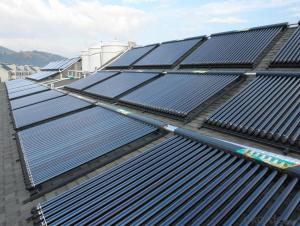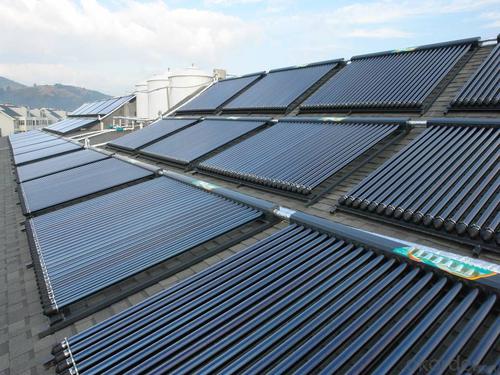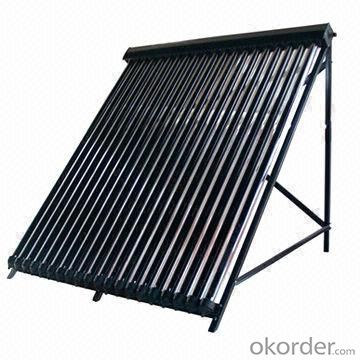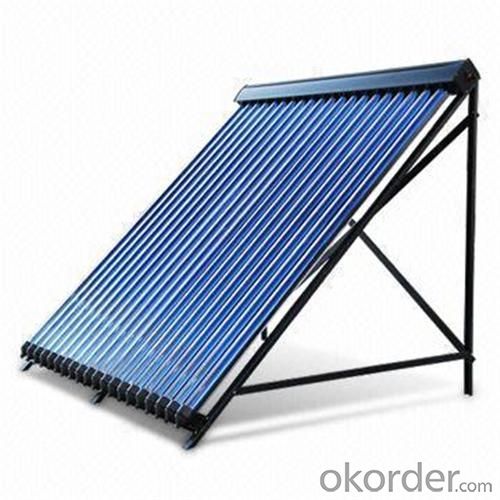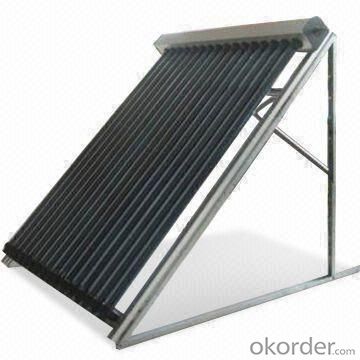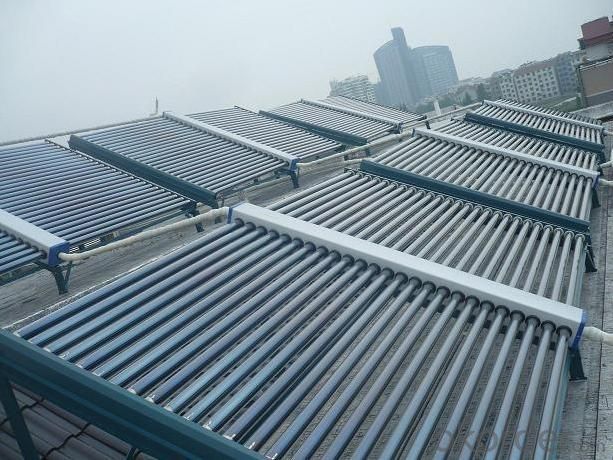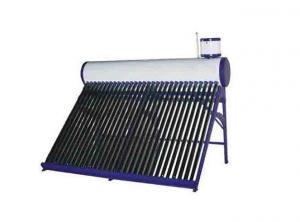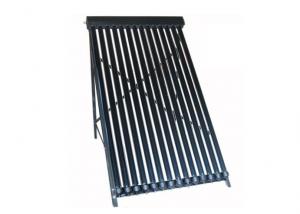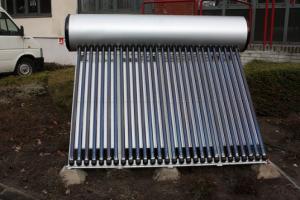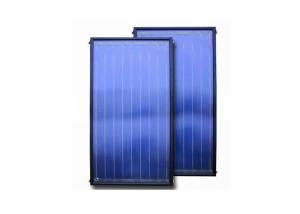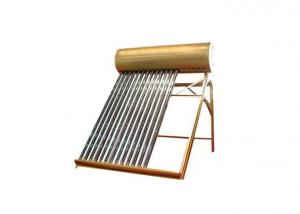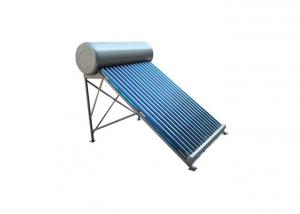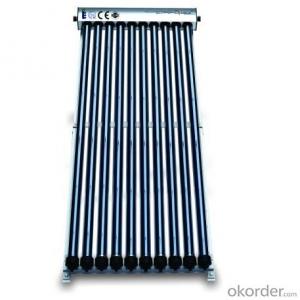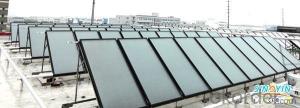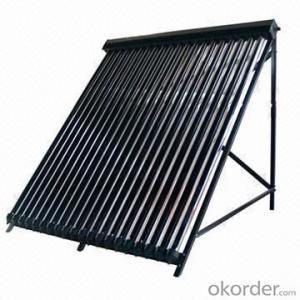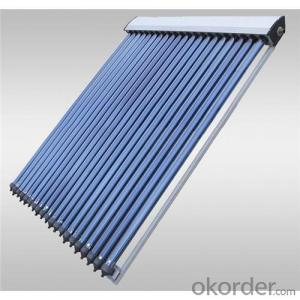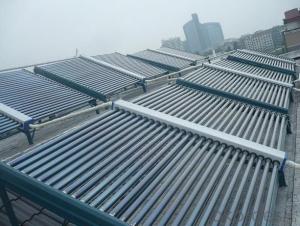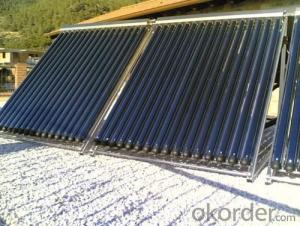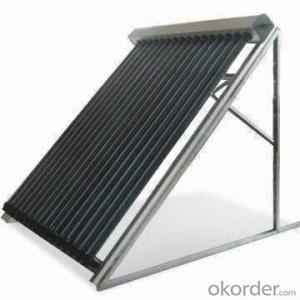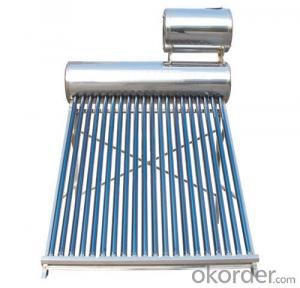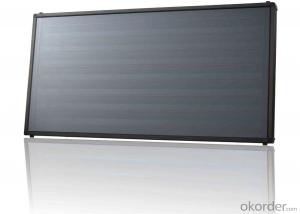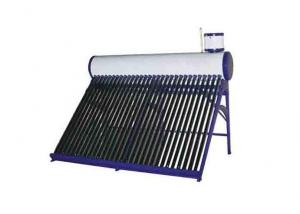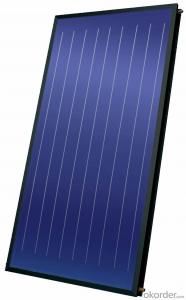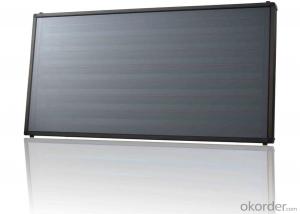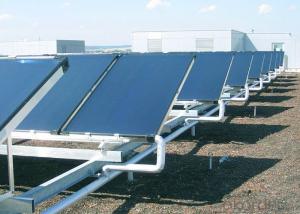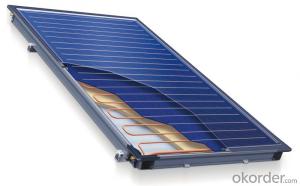Solar Collectors UK - 10 Tubes Solar Pipes Solar Collectors EN12975
- Loading Port:
- China main port
- Payment Terms:
- TT OR LC
- Min Order Qty:
- 5 set
- Supply Capability:
- 10000 set/month
OKorder Service Pledge
OKorder Financial Service
You Might Also Like
Specification
manifold (inner) | red copper |
manifold (exterior) | aluminum alloy |
glass tube dimensions | 58mm * 1800mm |
daily efficiency | ≥55% |
heat preservation | 72 hours |
hail resistance | 25mm |
max pressure | 7 bar |
coating of vacuum tube | ALN/AIN-SS/CU |
heat pipe | anti-freezing > -35 degree |
certificate | Solar Keymark, EN12975,SRCC |
Serious Product
Models | L*W*H mm | Vacuum tube | Power output | Efficiency | Header mm | Frame | container loading 20FT/40HQ sets | Gross Weight kg |
SHC-8 | 1917*910*133 | 58*1800*8pcs | 939W | 0.668 | Φ35/1.0 | AL alloy | 185/445 | 27 |
SHC-10 | 1917*1130*133 | 58*1800*10pcs | 1189W | 159/385 | 33 | |||
SHC-12 | 1917*1350*133 | 58*1800*12pcs | 1440W | 149/358 | 40 | |||
SHC-15 | 1917*1680*133 | 58*1800*15pcs | 1815W | 120/290 | 49 | |||
SHC-18 | 1917*2010*133 | 58*1800*18pcs | 2191W | 100/242 | 59 | |||
SHC-20 | 1917*2230*133 | 58*1800*20pcs | 2442W | 87/210 | 66 | |||
SHC-22 | 1917*2450*133 | 58*1800*22pcs | 2692W | 83/202 | 72 | |||
SHC-24 | 1917*2670*133 | 58*1800*24pcs | 2943W | 77/188 | 79 |
Packaging & Delivery
Packaging Details: | Exporting Carton with big foaming protection |
Delivery Detail: | In 10-15 days |
Loading Quantity
Model | Tube | Tube Q.T.Y | Loading Q.T.Y/40HQ |
GSC15 | 58*1800mm | 15pcs | 315sets |
GSC18 | 58*1800mm | 18pcs | 265sets |
GSC20 | 58*1800mm | 20pcs | 248sets |
GSC22 | 58*1800mm | 22pcs | 225sets |
GSC25 | 58*1800mm | 25pcs | 200sets |
GSC30 | 58*1800mm | 30pcs | 168sets |
Details of solar collector:
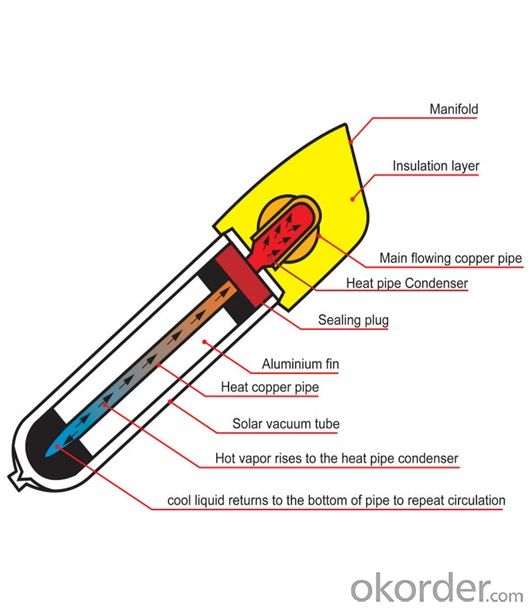
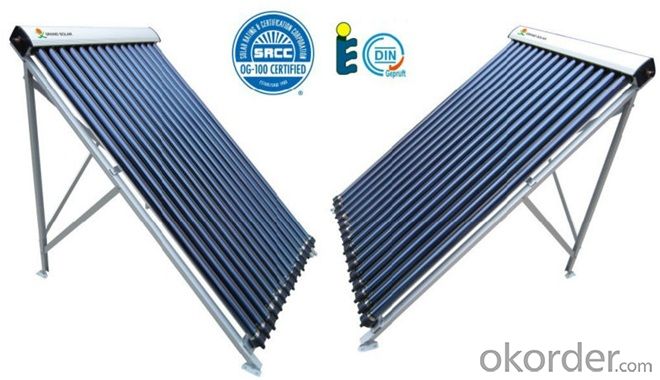
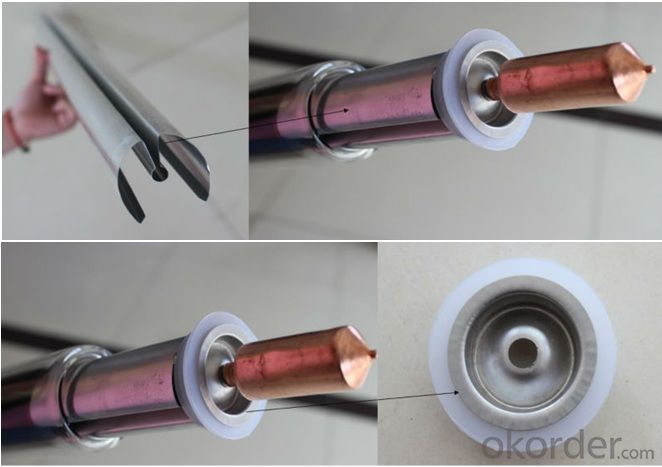
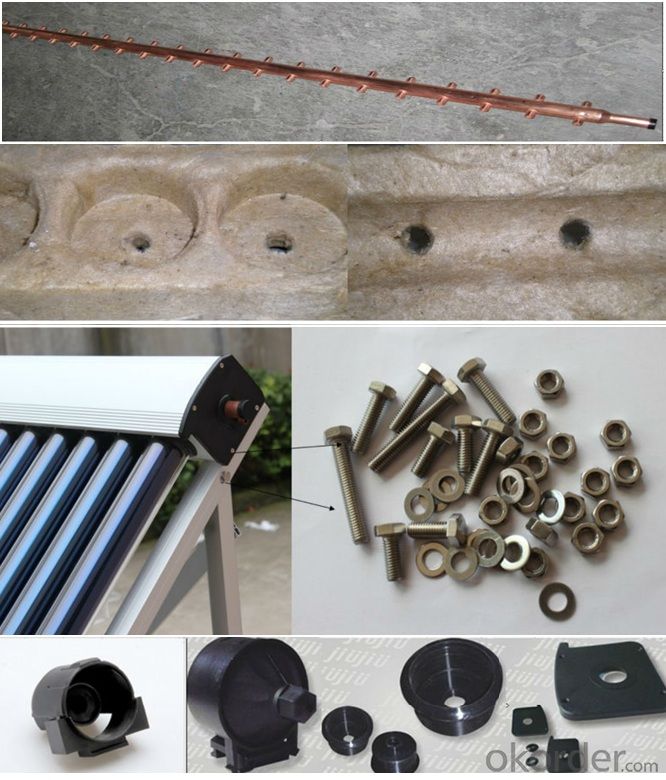
- Q: How do solar collectors compare to traditional heating methods?
- Solar collectors are a more sustainable and cost-effective alternative to traditional heating methods. They harness the power of the sun to generate heat, reducing reliance on fossil fuels and lowering energy costs. Additionally, solar collectors have a longer lifespan and require less maintenance compared to traditional heating systems, making them a more environmentally friendly choice.
- Q: Are solar collectors weather-resistant?
- Yes, solar collectors are weather-resistant. They are designed to withstand various environmental conditions, including rain, snow, wind, and extreme temperatures. The materials used in their construction are durable and can withstand the elements, making them suitable for outdoor installation in all types of weather conditions.
- Q: Can solar collectors be used for drying sports equipment?
- Yes, solar collectors can be used for drying sports equipment. The heat generated by the solar collectors can help in accelerating the drying process by providing a natural and sustainable source of energy. This can be particularly useful in areas with abundant sunlight, as it allows for efficient drying of sports equipment without the need for electricity or other energy sources.
- Q: Can solar collectors be used for heating research facilities?
- Yes, solar collectors can be used for heating research facilities. They can harness the sun's energy to provide heat through various systems such as solar water heaters or solar air heating systems. This renewable energy source can help reduce reliance on fossil fuels and contribute to a more sustainable heating solution for research facilities.
- Q: Can solar collectors be used in incineration plants?
- Yes, it is possible to utilize solar collectors in incineration plants. Solar collectors function as devices that convert solar energy into heat energy, which can then be utilized for various purposes. In the case of incineration plants, solar collectors can be employed to supply heat for the incineration process. Incineration plants are facilities that burn waste materials at high temperatures to generate energy. Typically, the heat produced from the combustion process is utilized to produce steam, which subsequently powers turbines to generate electricity. By utilizing solar collectors, the heat necessary for the incineration process can be supplemented or even replaced, thereby reducing reliance on fossil fuels and decreasing the carbon emissions associated with the plant's operation. To capture the sun's energy and convert it into heat, solar collectors can be integrated into the design of incineration plants. These collectors typically consist of a series of solar panels or tubes that absorb sunlight and transfer the heat to a working fluid, such as water or oil. This heated fluid can then be employed to provide the required heat for the incineration process. The utilization of solar collectors in incineration plants offers numerous advantages. Firstly, it diminishes reliance on fossil fuels, making the plant more sustainable and environmentally friendly. Secondly, it can help reduce operating costs by offsetting the need for conventional heat sources, such as natural gas or coal. Lastly, solar collectors can enhance the overall efficiency of the incineration process by providing a consistent and dependable source of heat. However, it is essential to note that the integration of solar collectors in incineration plants necessitates careful planning and engineering. Factors such as the plant's location, available sunlight, and the design of the solar collector system must be considered to ensure optimal performance. Additionally, the size and capacity of the solar collector system must be appropriately determined to meet the heat requirements of the incineration process. In conclusion, solar collectors can indeed be employed in incineration plants to supply heat for the incineration process. By harnessing the sun's energy, these collectors provide a sustainable and cost-effective solution to reduce reliance on fossil fuels and decrease carbon emissions in the operation of incineration plants.
- Q: Can solar collectors be used in areas with limited financial resources?
- Yes, solar collectors can be used in areas with limited financial resources. In fact, solar energy is often seen as a viable solution for such areas as it provides a clean and sustainable source of energy. Solar collectors can help reduce reliance on expensive and polluting fossil fuels, making energy more affordable and accessible for communities with limited financial means. Additionally, various financing models, such as microfinance initiatives and government subsidies, can help make solar collectors more affordable and feasible for these areas.
- Q: Can solar collectors be used in conjunction with other renewable energy sources?
- Yes, solar collectors can definitely be used in conjunction with other renewable energy sources. In fact, combining different renewable energy sources can enhance overall energy production and ensure a more reliable and consistent power supply. For example, solar collectors can be paired with wind turbines or hydroelectric systems to create a hybrid renewable energy system. This approach allows for optimal utilization of resources, as solar energy can be harnessed during the day while wind or water power can be utilized during periods of low solar radiation. By diversifying the energy mix, we can maximize efficiency and reduce dependency on non-renewable sources.
- Q: Are solar collectors suitable for agricultural greenhouses?
- Yes, solar collectors are suitable for agricultural greenhouses. They can effectively capture and convert solar energy into heat, which can be used for maintaining optimal temperature and providing supplemental heating in greenhouses. This helps in enhancing plant growth, extending the growing season, and improving overall crop yield. Additionally, solar collectors offer a sustainable and cost-effective solution for greenhouse operations by reducing reliance on traditional energy sources.
- Q: Can solar collectors be used for heating industrial facilities?
- Yes, solar collectors can be used for heating industrial facilities. Solar thermal systems can effectively capture and convert sunlight into heat energy, which can be used for various heating applications in industrial settings such as space heating, water heating, and process heating. The installation of solar collectors can help reduce the reliance on fossil fuels, lower energy costs, and contribute to a more sustainable and environmentally friendly operation of industrial facilities.
- Q: How do solar collectors compare to traditional fossil fuel-based heating systems in terms of emissions?
- Solar collectors are significantly more environmentally friendly than traditional fossil fuel-based heating systems in terms of emissions. Fossil fuel-based heating systems release greenhouse gases and other pollutants into the atmosphere, contributing to climate change and air pollution. On the other hand, solar collectors harness the sun's energy, producing zero emissions during operation. This makes them a cleaner and more sustainable option for heating systems.
Send your message to us
Solar Collectors UK - 10 Tubes Solar Pipes Solar Collectors EN12975
- Loading Port:
- China main port
- Payment Terms:
- TT OR LC
- Min Order Qty:
- 5 set
- Supply Capability:
- 10000 set/month
OKorder Service Pledge
OKorder Financial Service
Similar products
Hot products
Hot Searches
Related keywords
